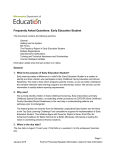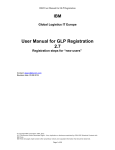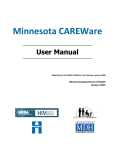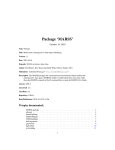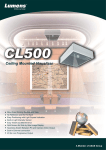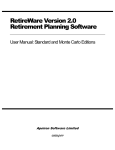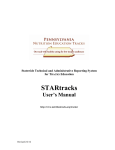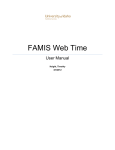Download Frequently Asked Questions: Early Education Student
Transcript
Frequently Asked Questions: Early Education Student This Frequently Asked Question document contains the following sections: General, Data from 2012-13, Getting Into the System, ED Forms, The People to Report, Multiple Registrations, Data Element Clarifications, Training and Technical Assistance and Scholarships and Course Catalogue Updates. General 1. What is the purpose of Early Education Student? Minnesota believes that early learning makes a difference in the lives of children and families. Parents are children’s first and most important teachers. The programs parents select for their children vary over time and makes a difference as children enter kindergarten. Minnesota needs to understand more about the public expenditures selected by parents prior to kindergarten. Early Education Student will support that need. Early Education Student provides a mechanism to identify children participating in Early Childhood Family Education and School Readiness to better understand experiences prior to kindergarten across multiple public funding streams. This work will increase opportunities to better understand transition strategies between early learning programs and elementary school. 2. Why now? Children are moving into more and more environments prior to kindergarten that their parents select for them. The Dayton administration is leading the nation in pioneering new financing options for preschool services as well as a range of other opportunities. Currently procedures are in place to uniquely identify children in Early Childhood Screening, Early Intervention and Early Childhood Special Education to understand the experiences of young children. Extending similar procedures to ECFE/SR (Early Childhood Family Education/School Readiness) is the next step in understanding patterns and pathways prior to kindergarten. Federal grants secured from the Statewide Longitudinal Data System and the Race to the Top Early Learning Challenge Fund competitions are supporting the implementation of Early Education Student in line with Governor Dayton’s Seven Point Plan for Achieving Excellence for Better Schools for a Better Minnesota. Page 1 January 2014 3. What is the schedule of implementation? Phases Training Start Pilot November 2012 Dec 2012 Aug 2013 Portion of 2012 Round 1 August 2013 Sept 2013 Mar 2014 SFY 2013 Round 2 (statewide) May 2014 June 2014 Aug 2014 SFY 2014 PI and PII Scholarships January 2014 Feb 2014 Oct 2014 SFY 2014 Statewide (Regular) June 2015 Aug 2015 SFY 2015 May 2015 Complete Reporting Period See the User Manual for district assignment to the phases. PI = Pathway I and PII = Pathway II for state scholarships. 4. What is the actual due date? The first or last day of the month? The last day of the month. 5. Can our district require a birth certificate to enroll children in ECFE or School Readiness? First of all – birth certificates are one option districts can use to verify age but if families cannot provide one services cannot be withheld. Birth certificates cannot be required for registration or enrollment in any school-based program. It cannot be used as a reason to keep families out, formally or informally, of early childhood programs. There is no reference to birth certificates in state statute. MDE instructs families of this when contacted. Districts have a range of options for documenting a child’s name including birth certificates, passports, baptismal records, health care records and similar documents. Second, families served by early childhood programs by legislative direction have higher rates of all categories of populations less likely to have formal documentation. Early childhood programs are also working within a voluntary – not mandatory – environment as compared to K12. It is critical that MARSS staff work behind the scenes in supporting early childhood staff in developing these policies. Third, it is also critical to the system that early childhood staff work with MARSS staff to best document children’s names as accurately as possible to be able to follow children moving forward. Populations with the least likelihood to have the documentation are those with the most likelihood to demonstrate a positive impact of early childhood programming. Meet with your colleagues in Early Childhood Screening, Early Intervention and Early Childhood Special Education to understand how they have handled similar issues in their program. Data from 2012-13 6. Why? This is tied to timelines in the federal Race to the Top grant Minnesota received in 2011. Page 2 January 2014 7. Do we need to get demographic data from families that participated in 2012-13? No. Use the default values provided where there are required values. Note – there is only one element from the Parent Questionnaire (parent, grandparent, etc.). Getting Into the System 8. I’ve requested access to the system multiple times. Some of my acceptances have been accepted and others rejected. Am I in or out? You are in and should be able to enter data or upload a file. If not, please ensure your superintendent has sent authorization on your behalf. Then contact [email protected] to see what next steps are needed to get you into the system. 9. I forgot my password – what do I do? This happens to everyone. Click the link on the log in screen for more information if you’ve forgotten your password or ID. 10. Is there a link to the State Student Identification system to correct any issues? Yes! This is built into the program to help districts quickly resolve any data errors. Users will need to have a Superintendent’s authorization in place for the State Student Identification Validation system. Note that this is separate from the Superintendent’s Authorization for Early Education Student. 11. Is this a legitimate expense for ECFE and/or School Readiness? Yes. Fund 1 or Fund 4 funds may be used. 12. Do we have to use the parent letter? No. Many districts are creating notes to attach to the Parent Questionnaire describing the importance of the information to increase response rates. They describe that the information is important to describe the breadth and depth of programming available from the district. MDE is happy to review if you’d like to send your district’s version so that others may also use it. ED Forms 13. What forms are we to use? For the 2013-14 school year, districts are to provide to parents the Participant Questionnaire (ED-002309-14) used in previous years in the program along with the Parent Questionnaire (ED-02470-01) for EE Student (Early Education Student). It is voluntary for the parents to respond to both forms. It is the goal for 2014-15 that only the Parent Questionnaire (ED-02470-01) for EE Student is used with parents. Page 3 January 2014 Based on district request, MDE created the Early Education Student ED Form (02471-01). This is NOT to be distributed to parents as it will not make sense to them. The terms are ones used by the program areas. It may facilitate communication between the Early Childhood and MARSS offices if MARSS is doing all of the data entry. Use it ONLY IF it helps your district. At trainings from November 2013 forward, the ED forms are associated with colors. The Participant Questionnaire (ED-002309-14) is green, the Parent Questionnaire (ED-02470-01) is blue and the Early Education Student Form (02471-01) is yellow. 14. Can we combine the two Parent Questionnaires? Yes this is a district option. Ensure that data entry staff understand which response goes to which data submission. Note that some districts are choosing to attach a cover letter explaining to parents that the responses to these questions support state funding for the program and provide an overall picture of the depth and breadth of the program. 15. Why are the demographic questions the same across scholarships, School Readiness and ECFE? This was done intentionally to align the reporting across program areas and simplify administration. Parents need only complete one per year. The district may gather the information in any format (online registration, paper and pencil, interpreters, etc.). 16. What are some options on how to distribute the Parent Questionnaire? Based on experiences from the Kindergarten Entrance Assessment, districts may want to present the questionnaires during special events or parent teacher conferences, with an envelope for each parent. Then the parent places their response in a larger manila envelope before leaving. That manila envelope is then passed to the person doing the data entry. 17. What do we do if it is not the parent attending with the child? Use the practices your district previously did with the Participant Questionnaire. Often, districts will ask that the person attending takes the form home to the parents for them to complete and then return. The People to Report 18. Why is parent name and DOB requested? Parents are children’s first and most important teachers. They love their children like no one else and know their child better than anyone else. We hope that parents are with their children for many, many years to come. While many things may change over time, we do hope that a parent’s name is one of the more constant things in a child’s life. A DOB one would hope would remain constant. Each element that we can add to a child’s file that will remain relatively constant over time helps solidify that child’s identity over time. It helps Minnesota build a database for effective public policy across Page 4 January 2014 funding streams. This is especially our hope as children in early childhood move across education, child care and home-based health services such as home-visiting nursing services. Data submitted through this system will meet all state and federal data privacy requirements. Parent name is only required for Pathway I and Pathway II scholarships. 19. If a child registers for a program but does not attend, are we to report that child? No. 20. Are we to report people attending one-time events like speaker nights? No. 21. Are we to report children in child care? No. The only caveat to this is for children accessing child care sites through state scholarships. For the 2013-14 school year, only Rochester, St. Paul and Owatonna school districts are piloting this approach with special arrangements with the Regional Grant Administrators. 22. Our district goes beyond School Readiness funding and provides preschool services with other funding sources. Are they to be included too? If the children are in a public school building, taught by public school staff, whether or not those staff are on the teacher contract, those children are to be reported as well. Please clarify the funding sources for those children under that element. 23. Our district partners with Head Start and/or child care. How do we distinguish them in the software so we don’t report the Head Start and/or child care children? Contact your software vendor to clarify. 24. Our ECFE/SR program partners with Early Intervention/Early Childhood Special Education with joint classrooms or we have children enrolled in both program areas. How do we distinguish these children in the system for export without disrupting the EI/ECSE MARSS export? Talk with your software vendor. Children in EI/ECSE must be maintained for the regular MARSS uploads with their associated site numbers to ensure the district receives proper reimbursement. It is the goal of EE Student to reflect all children participating in ECFE and SR regardless of special education status. If the district must choose however, ensure the special education status is maintained to generate general education revenue. Notify the software vendor that the district is very interested in being able to report all ECFE/SR children for subsequent years similar to how a district can report a child in first grade and participating in special education. Page 5 January 2014 25. What if a family attends a program in two separate districts simultaneously? Which district reports the registration? Both. This will not cause an error. Multiple Registrations 26. What do I do if a child/family registers for a fall AND a spring course? Change the count of classes to two. Leave all other the data the same. The course catalogue for early childhood will capture this data when it is released. 27. If one child attends two different classes with the two different parents, how do we record that information? On the registration the child will be enrolled in two classes and have two parents listed. 28. Our District is in Phase I – how do we handle confirming official names for infants and toddlers from ECFE from the 2012-13 school year? This is a district by district decision. One leading district made the decision to wait until fall knowing that a large majority of their infants and toddlers would be returning to the program and they decided to request documentation at that point in time regarding the child’s name. At that point they would assign the State Student Identification Number. Then for the infants and toddlers that did not return from the 12-13 school year, they plan to record the child’s name as recorded by the parent through the best documentation available on file. Other districts started working right away on assigning the numbers. It all depends on local staffing resources and preferences. 29. What do we do if the parents bring in two separate forms of legal papers and the child’s information differs based on which form is used? This is a district decision on which form should take priority. Check with your MARSS office. 30. What if a family from a border state attends a program? Assign a State Student Identification Number. It does not generate general education revenue. 31. What if a child is receiving a scholarship? See the codes in the User Manual under Funding Source. Be very careful regarding the term “scholarship” as there are a number of options currently existing. Please confirm with the Early Childhood Coordinator if THERE IS ANY DOUBT. If the child is receiving a scholarship from School Readiness Program funding – use code 02. This is the program funding that has been available historically through the formula funded program in Minnesota Statutes 124D.15. If the child is receiving a scholarship through the state scholarships expanded through the 2013 state legislature (Minnesota 2013 Session Law Chapter 116, Article 8, section 2), identify whether the child received a Pathway I or Pathway II scholarship with the Early Childhood Page 6 January 2014 Coordinator. The scholarship variables, which vary slightly, are the variables that will be required within EE Student. This includes parent name, county and sibling information. Sibling information is only required when a sibling is accessing a scholarship. The following EE Student elements are not applicable to Scholarship: migrant status, McKinney-Vento, special needs, count of classe, hours/days attended and services referred from/to. If the child received a Race to the Top federal scholarship in 2013-14 or 2014-15 which were focused in Minneapolis, St. Paul, White Earth and the Invest Early areas, mark the child as receiving a “Community Scholarship.” 32. We have a public preschool in a public school building taught by public school employees but they are not on the teacher contract. Do we report those classes? Yes. 33. What if a child attends both ECFE and School Readiness? Or School Readiness and Early Childhood Special Education? For the child attending ECFE and School Readiness, they are reported under both programs. It is similar to a child attending two different schools – both schools would report that child. It is ok for a child to be listed twice in EE Student. For a child attending School Readiness and Early Childhood Special Education, the child is reported in both EE Student and MARSS Finance. This will not cause an error. 34. If a family is attending ECFE and School Readiness with two different teachers, will the registrations be tied together on the back end? Yes through the State Student Identification number. Report the child under both programs. 35. Is there a deadline for the superintendent to provide their authorizations for staff in the system? No – there is no deadline. Staff can only access the system after they have been authorized. It is to staff’s advantage to have early access to be able to learn the system and submit data in a timely manner. Data Element Clarifications 36. For ECFE, under Parent Participation Type, what should we list for parents who are not volunteering above and beyond regular ECFE classroom activities with their own child? Not participating. Page 7 January 2014 37. What is to be marked if the family pays the full amount due based on a sliding fee scale? Is it “Full fee” or “partial fee”? If families are paying the top tier rate for your district (i.e. the highest rate charged by your district whether it is on or off the sliding fee scale), they are paying the full fee. If they are not paying the top tier rate for your district, they are paying a partial rate. 38. What do I do if a child changed a name from FY13 and now? Use the new name. Connect to the previous SSID number. 39. For income, do I list the income for one parent or both? It is household income. You may list both but do not need to list both parents if they are not both attending with the child. 40. For immunizations, what if they are a conscientious objector? Or if they are in progress to get their immunizations? Does the conscientious objector letter need to be notarized? Conscientious objectors meet the current requirement. The family only needs to be up to date at one point in the year. The letter does not need to be notarized. 41. For immunizations, which immunizations are to be included? Use the schedules listed at http://www.health.state.mn.us/divs/idepc/immunize/schedules.html 42. For immunizations, are we going with the “recommended” or “overdue” dates? Recommended. 43. When we indicate funding source for an EE Student, is it assumed that ECFE is also a funding source for an ECFE class? Yes. This is only for ECFE. School Readiness may have a student attending only with parent fee in some districts. 44. Can we indicate more than one funding source? Absolutely! The goal is to reflect the complexity that administrators go to for hosting these sessions. For School Readiness, if they are paying no fee then some source should be identified. 45. What is McKinney-Vento status? Homelessness status. See MARSS manual for more information. Page 8 January 2014 46. Why don’t the race/ethnicity codes exactly match those in MARSS? Those codes are driven by federal funds. Neither School Readiness nor ECFE receive any federal funds through the state. Training and Technical Assistance 47. Where do I get more information? After reviewing the materials online, please contact Christine Hennessey at [email protected] to set up a telephone call. Include two to three times you and any other interested staff are available in the next several weeks. Allow a minimum of 30 minutes for the call. 48. Do I need the leader code for telephone calls? No. That will be entered by state staff. Scholarship and Course Catalogue Updates 49. Why was an updated format released? This was done to support the reporting of children accessing state Pathway I and Pathway II scholarships. Note – federal Race to the Top scholarships isolated to the four Transformation Zones are not to be included as Pathway I or Pathway II. 50. Why were the attendance variables added? These are placeholders for the release of the early childhood course catalogue. Districts may disregard these for 2013-14 and prior data. 51. What is a course catalogue? It is a way to report the length of time a class was available, the design of the class and who attended. It is very similar to information needed to develop a high school or college transcript. All existing state and federal data privacy regulations will apply to this information as well as EE Student. The K-12 sections of the district are working on implementing the high school and K-8 versions of the course catalogue currently. 52. When will the early childhood course catalogue anticipated to be released? MDE staff will work with interested districts beginning in spring 2014. Other districts will come on after that point as software vendors update their systems. This will likely take anywhere from 9 to 18 months from the first release for software systems to be ready. 53. Will there be a similar deadlines set out for the early childhood course catalogue as there was for Early Education Student? Page 9 January 2014 In short, no. Districts will opt in to reporting this based on their software capability. Note that the preschool section of the course catalogue is a part of the federally mandated America Competes Act. 54. Will the early childhood course catalogue be as complex as the K-12 course catalogue? In most instances, no. Early childhood has fewer classes, calendars and students. 55. IF there are resources locally to archive information, what should I be saving to report for the course catalogue? If your district is in the enviable position to be able to archive information, save program brochures that describe the registration options and which students attended the different classes. Course catalogue reporting is done after the end of a school year for all age groups so historical information can be reported when available from a software vendor system. This is not required. Page 10 January 2014










